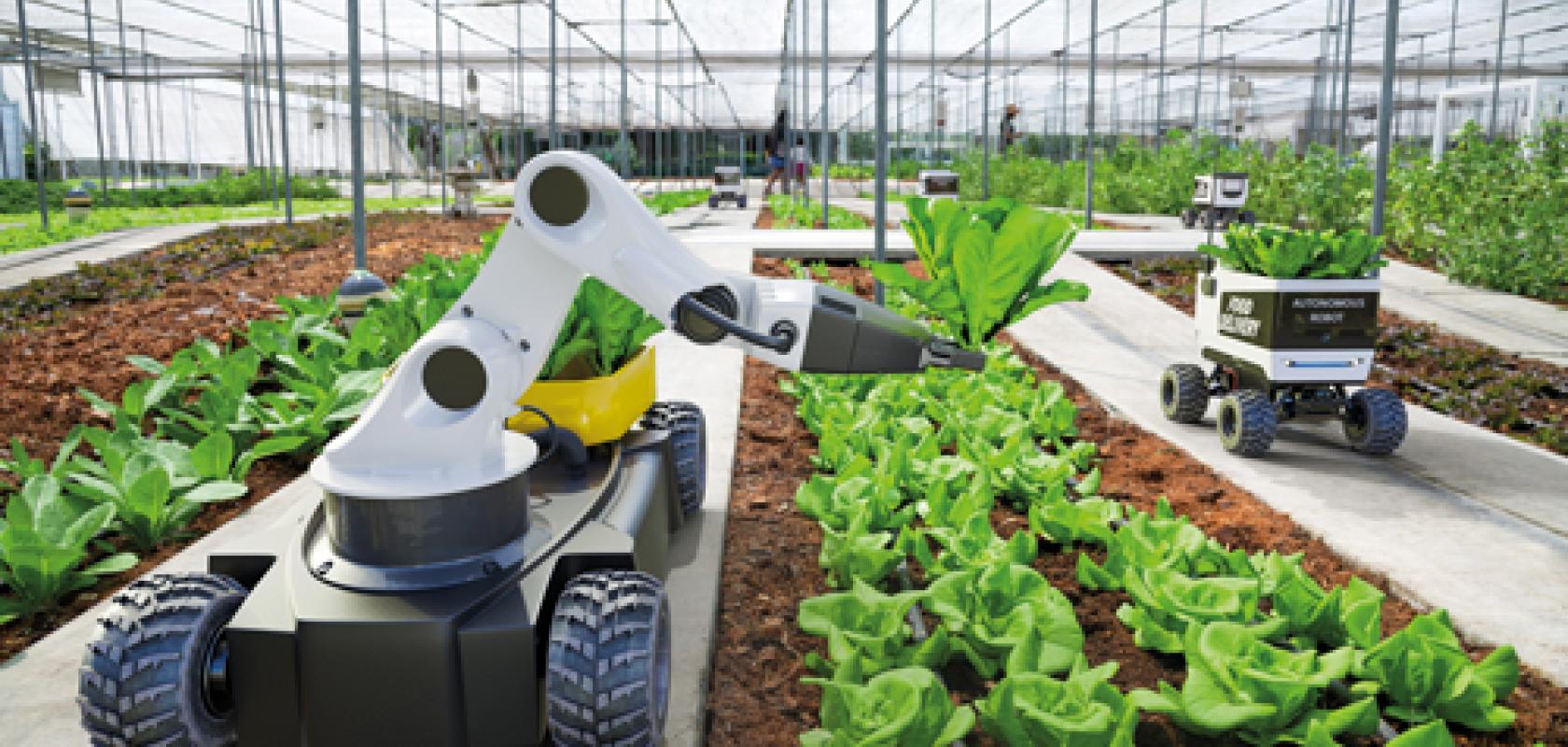From agriculture to AI, spectroscopy improvements are driving the technology into new areas. Experts shared new applications, latest developments and looming challenges with Matthew Dale during a recent Electro Optics webinar
Modern spectroscopy solutions offer continually increasing sensitivity, resolution, accuracy, speed, integrability, affordability and user friendliness, all in ever-smaller physical footprints. This has led to the technology becoming adopted across a wide range of industries and applications, both in the lab and out in the field.
Such was shared in a webinar recently hosted by Electro Optics that covered the latest applications, developments and challenges of spectroscopy.
According to speaker Nazanin Shafiee, Director of Strategy & Business Development at Avantes, the future continues to look bright. Avantes expects an increase in the uptake of spectroscopy technologies across the industries it serves, including semiconductor, medical, pharmaceuticals, biotech, food & agriculture and environmental monitoring. Nor is this confined to mature companies that have long considered spectroscopy a crucial and well-established part of their operations.
Start-ups and scale-ups are also adopting the technology in new and innovative ways. As modern spectrometers become smaller and more portable end users can more easily integrate the technology into handheld devices and tools for new applications in the field.
Consistent spectroscopic data is key
Shafiee highlighted improvements in data analysis and interpretation using artificial intelligence (AI) as important developments.
“This is quite significant, because with the emergence of AI, what we can now do is combine it with spectroscopy to develop algorithms using machine/deep learning,” she explained. “These algorithms are developed and trained using collected spectroscopic data to recognise patterns on key indicative metrics that our customers are looking for, or find new metrics that they may not have previously looked for.”
In developing such algorithms, it’s important that the training data is consistent and reliable – not only when obtained from one spectrometer over a period of time, but potentially from a number of different systems in the same setting. Shafiee said the data must have “as reduced standard deviation as possible” to ensure it is of high enough quality to be used for training algorithms. To facilitate this, Avantes has upgraded its production capabilities – manufacturing process controls, sub-assembly levels and automated manufacturing processes – to deliver spectrometers with improved sensitivity, resolution, accuracy, and, importantly, higher unit-to-unit reproducibility.
One such spectrometer is Avantes’ new AvaSpec Pacto, which Shafiee introduced as a “next-generation photonic backbone spectrometer designed to empower a wide range of applications in various industries”. Shafiee said the system is compact, lightweight and powerful and “offers high-speed performance with integration times of up to nine microseconds, minimal stray light as low as 0.1%, and a strong signal-to-noise ratio of 375:1. We also offer various communication protocols for it. Pacto can be optimised using six different slit sizes, more than 15 types of grating, and all of these features essentially make it a highly suitable spectrometer for OEM and non-OEM applications.”
She added that the Pacto also offers the option to choose from different communication protocols, further enhancing its versatility, and that it is also compatible with Avantes’ light sources and software, allowing integration with other products or systems.
Closing the expertise gap
A particular challenge often faced by spectroscopy firms, according to Shafiee, arises in applications of increased specialisation, where niche areas of deep expertise are often created by experts in that particular field. While this of course benefits the field, it can create gaps in knowledge that then need to be filled when serving such specialised applications using spectroscopy. “For example, in some of the medical applications where spectroscopy can be enormously helpful, either us (the spectrometer expert), or the end user (doctors or medical professionals) need to close that gap,” said Shafiee. “It’s typically the latter that happens. Our expert customers, with a need in their mind, come and learn more about how they can close that gap. Every so often though, we see that it’s not easy for our end customer to bridge that gap. They have deep expertise in their own field, but they don’t have access to teams to build a model for their application.”
Spectroscopy firms all react differently to this challenge, she continued. “Some take it upon themselves to build the application, however we at Avantes don’t choose to do that. This is because, in a sense, we would end up competing with some of our customers. And we want our customers to feel safe when they’re discussing technical details and so that they know that their IP is well protected with us. The way we go around that challenge is we work with other partners, who then work directly with our end customers and support them with their application development if need be.”
Spectroscopy for precision agriculture
Gaetano Panagia, Technical Marketing Engineer at Hamamatsu Photonics Europe, shared his views on how miniaturised spectroscopy could impact the future of food and agriculture.

Spectrometry can be used to assess soil quality and optimise irrigation, helping farmers save water (credit: Shutterstock/Sh_Vova)
He began by highlighting one of the key challenges humanity could face in the future. “In 2021, it was estimated that 11% of the world population was undernourished,” he said. “The situation won’t seem to get any better when we look at the forecast for population increase – which is expected to rise by 40% between today and the year 2100, reaching up to 11bn people. This could pose a serious threat to our food supply.”
He explained that one of the proposed solutions to this challenge is ‘precision agriculture’, which as a term covers several different topics. “One of these is the selection and bio-engineering of seeds that allow us to produce better-quality crops at higher yields and with more resistance towards parasites and climate change. Another is the application of robotics and automation technology to optimise growth and harvesting of our crops.”

The miniaturisation of spectrometers makes them easier to integrate in portable devices that can be taken out in the field, removing the need to send samples to the lab (credit: Shutterstock/sutadimages)
Miniaturised spectroscopy could play a number of different roles in facilitating precision agriculture, Panagia explained. “Firstly, it can be used to assess soil quality and optimise irrigation, thus sparing water. Similarly, it can be used to optimise the quality of fertiliser that we apply to soil. This not only helps reduce costs, but also reduces the pollution that can be caused by fertilisation. It can also be used on automated harvesting systems, helping determine when the best time to harvest a specific crop.”
Following harvesting, miniaturised spectroscopy could also play an important role in helping people select foods according to their chemical and physical properties, as well as detecting adulteration in food. “High-value foods such as milk, honey, olive oil and wine are increasingly getting tampered with lower quality substances,” said Panagia. “Spectroscopy can detect these adulterations and help improve not only the food quality of foods, but also our health.”
Rapid adoption of portable systems
With regards to the market of spectroscopy in precision agriculture, Panagia highlighted that benchtop spectrometers currently represent a larger portion of the market and are set to increase from €233.3m in 2022 to €342.8m in 2027 (a CAGR of 8%). Portable instruments will increase from €47.2m to €112.6m over the same time period (a CAGR of 19%). The main reason for the difference in market size between the two spectrometer types, Panagia noted, is that handheld systems are in general much cheaper than their benchtop counterparts.
He attributed the rapid growth of portable instruments to the wide range of new capabilities offered by portable spectroscopy. “Traditionally, if a customer wanted to analyse some soil, for example, they would have to get a sample, send it to a lab, and then await the analysis and results. This whole process would take days, sometimes even weeks. Nowadays the spectrometers are shrinking in size, which means we can integrate them into large machinery like tractors and sorting machinery. They are even getting all the way down to the size of a fingertip, enabling them to also be integrated into mobile devices. Having these portable systems out in the field reduces the time between sampling and the point at which a decision is made based on the results, up to the point that decisions can now be made in real time.”
Ongoing spectroscopy challenges
Panagia cited facilitating the widespread adoption of the technology by non-technical users as one of the main challenges facing spectroscopy. However, he said improvements to chemometrics – the set of algorithms used in spectroscopy to translate spectra into physical and chemical information, which in turn can inform the user about the decisions they need to make – are helping address this challenge.
Sample presentation was also highlighted as a challenge by Panagia, particularly for precision agriculture: “This is because in agriculture samples come in so many different forms – soil, seeds, liquids, fruits, etc – and we always need to present the samples to the spectrometer in a specific way in order for the measurement to be reliable and repeatable.”
Lastly, he cited the continual need to improve signal-to-noise ratio in order to be able to detect smaller and smaller concentrations of a substance in a sample. “This is especially true for reflectance measurement, and this is where Hamamatsu is proposing some innovation,” he said. “We recently released a new special lamp, the L16462-01, to improve signal-to-noise ratio in both our FTIR engine and any other spectrometers working in near-IR wavelengths, specifically between 1,100-2,500nm. The lamp design includes four halogen lamps. It has an output power of 2.5W, a footprint of 28 x 35.5mm, and a 7,000-hour lifetime. The light from the lamp is diffused/reflected by the sample and then conveyed into the built-in optical fibre, which brings it to the spectrometer.”
In conclusion, Panagia remarked that Hamamatsu Photonics is continually working to address each of these challenges to equip industry with the best possible technology. “We’re also committed to helping people, for example through improving the quality of our food, and to Earth, for example by reducing the amount of potentially harmful fertiliser that we use in agriculture, while also reducing the amount of waste we produce.” (In addition to precision agriculture, recycling is one of the potential applications of the L16462-01).
Overall, the future looks very promising for spectroscopy firms and customers alike. System specs continue to improve, the markets and number of applications continue to grow, and increasingly intelligent data analysis algorithms are emerging to reveal previously unknown metrics to customers.
Sponsored: Increasing yields and recovering scrap materials in pharmaceuticals

In the pharmaceutical industry, issues related to full reagent use and rigorous cleaning validation are often linked to additional production costs and decreased yield. Yet carefully considered implementation of spectroscopy solutions into existing processes can help. Indeed, with spectroscopy-based monitoring systems, manufacturers and contract development and manufacturing organizations (CDMOs) can streamline process efficiency, reduce waste and improve operational compliance.
The challenges: recovery, waste, and compliance
CDMOs typically face one or more common processing challenges related to recovery, waste, and compliance:
- Reagent recovery: If chemical reactions are not complete before production ends, reagents may be lost. Stopping the process early may produce a portion of the intended result, but the chemicals left behind are often unrecoverable and become waste.
- Cleaning-related waste: To avoid cross-contamination when switching production of one drug to another, many organizations opt for over-cleaning methods to ensure runoff doesn’t contain unexpected reagents. Over-cleaning reduces risk but takes longer to perform and requires more resources.
- Chemical disposal compliance: Regulatory bodies have codified policies on the handling and disposal of pharmaceuticals for manufacturers, healthcare agencies, and end users. For disposal processes to be effective, drug makers need to know precisely what chemicals — and in what concentrations — are found in their production waste.
The solution: situation-specific spectroscopy
Purpose-built spectrometers can help companies reduce reagent loss, minimize waste, and improve disposal compliance.
Consider production line reactions. By integrating spectrometers into processes, companies can accurately determine reagent amounts and better manage reaction processes. For example, a Raman spectrometer can be used to measure the vibrational energy of molecules in products and solutions in real time to determine if reactions are fully complete.
For cleaning validation, both absorption through flow cells and analysis with Raman spectrometers offer a way to ensure that chemical concentrations in vat runoff have decreased enough that new production runs can begin. Many vats are fully clean after 24 hours, but companies may run them for 72 hours or more as a way to ensure complete cleanliness. With spectral monitoring employed, cleaning can be accomplished more quickly and with less cleaning solvent necessary.
The benefits: doing more with less
Given the time and investment required to develop new drugs, pharmaceutical companies are always seeking new ways to better manage production processes. By using precise and reliable spectroscopy to ensure reactions are complete and cleaning validation is comprehensive without being wasteful, pharmaceutical producers are better prepared to deliver a sustainable return on investment.
Streamlined processes
Even minor changes in production line processes can result in wasted reagents or contaminated processes. Purpose-built spectrometers can detect tiny fluctuations in chemical composition, making it possible to pinpoint potential problem areas quickly.
This also applies to cleaning processes. Rather than relying on staff to ensure that vats are cleaned for a pre-selected amount of time for validation, the use of inline absorption or Raman analysis allows companies to easily check current runoff levels.
Inline, real-time analysis of chemical reagent reactions allows organizations to incorporate product evaluation as part of standard operating procedures. In practice, this removes the need for product samples to be captured and sent to onsite or third-party labs for analysis.
Operational innovation
There’s also a case to be made for spectrometers as a catalyst for operational innovation. Consider a pharmaceutical company running test batches of a new product. Inline spectroscopy can help identify areas for process improvement based on how well reagents combine and how long the process takes.
When it comes to waste, custom-built spectrometers can a) ensure that waste product concentrations adhere to regulatory expectations, and b) identify waste materials that fall under the threshold for active pharmaceutical ingredient-containing hazardous waste disposal.
The results: increased yields, better savings, and reduced waste
By implementing inline or at-line spectroscopy solutions from Ocean Optics, pharmaceutical firms and CDMOs are better equipped to monitor ongoing chemical reactions and ensure completion, recover unused reagent portions, and streamline cleaning validation processes.
The result is an operational trifecta that allows organisations to improve product yields, increase scrap savings, and reduce total waste. Spectral systems also provide more accurate insight into chemical disposal compositions and the actions required to ensure regulatory compliance.
Advanced, accurate, and agile spectroscopy is a clean sweep for pharmaceutical companies looking to maximise revenue and minimise waste in a rapidly expanding market.
Further information
For more information about spectroscopy solutions from Ocean Optics, an Ocean Insight brand visit: www.oceaninsight.com


